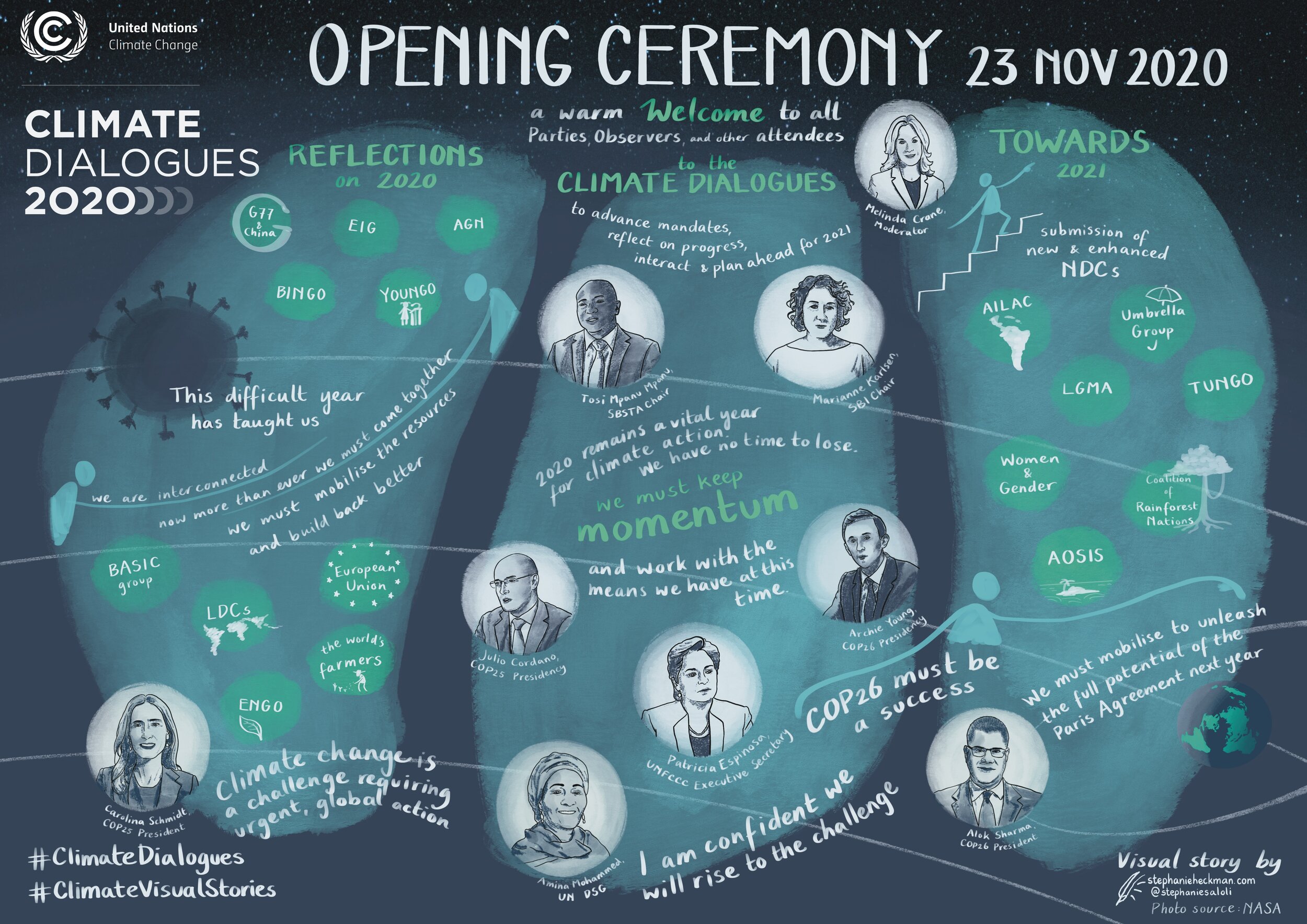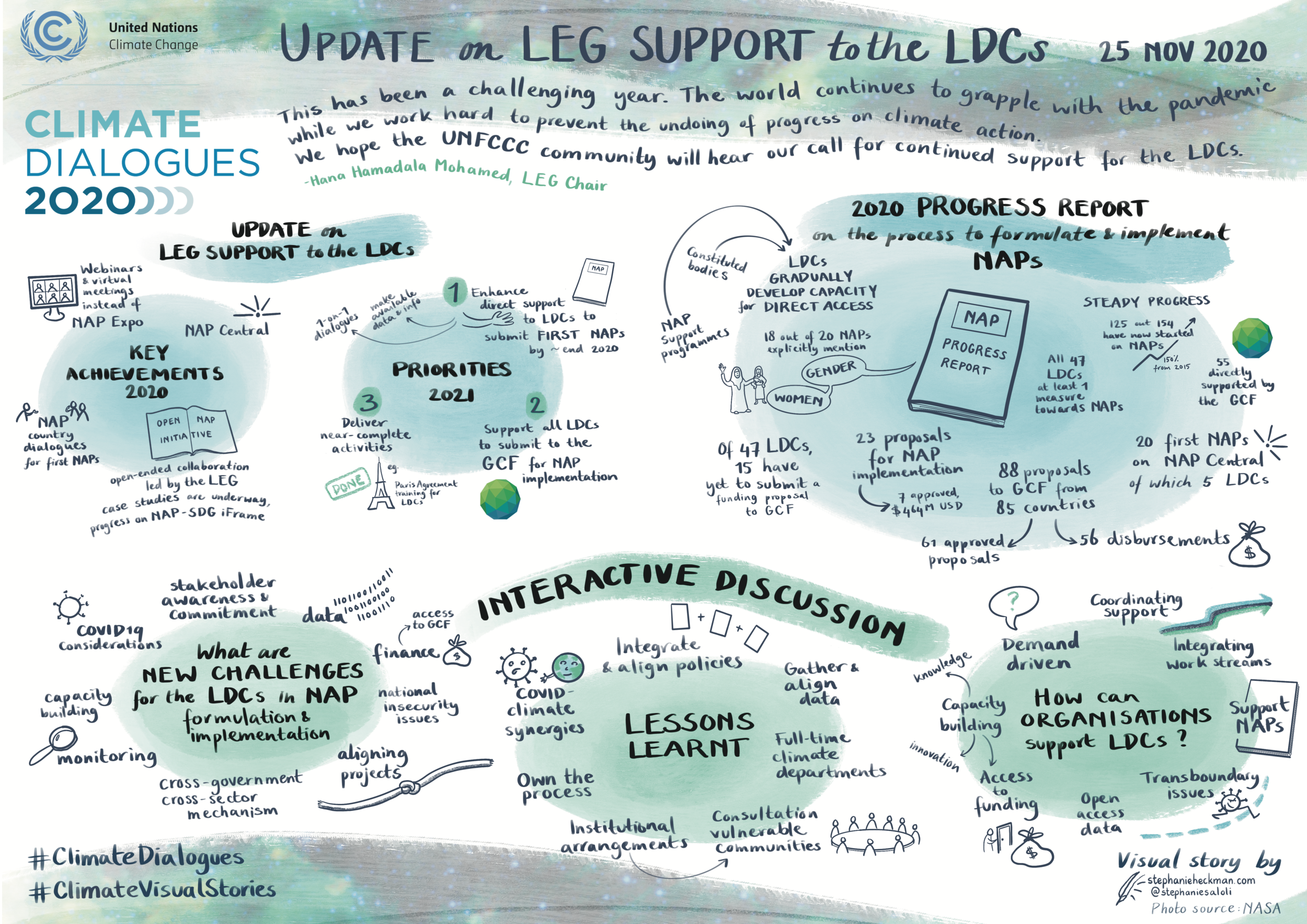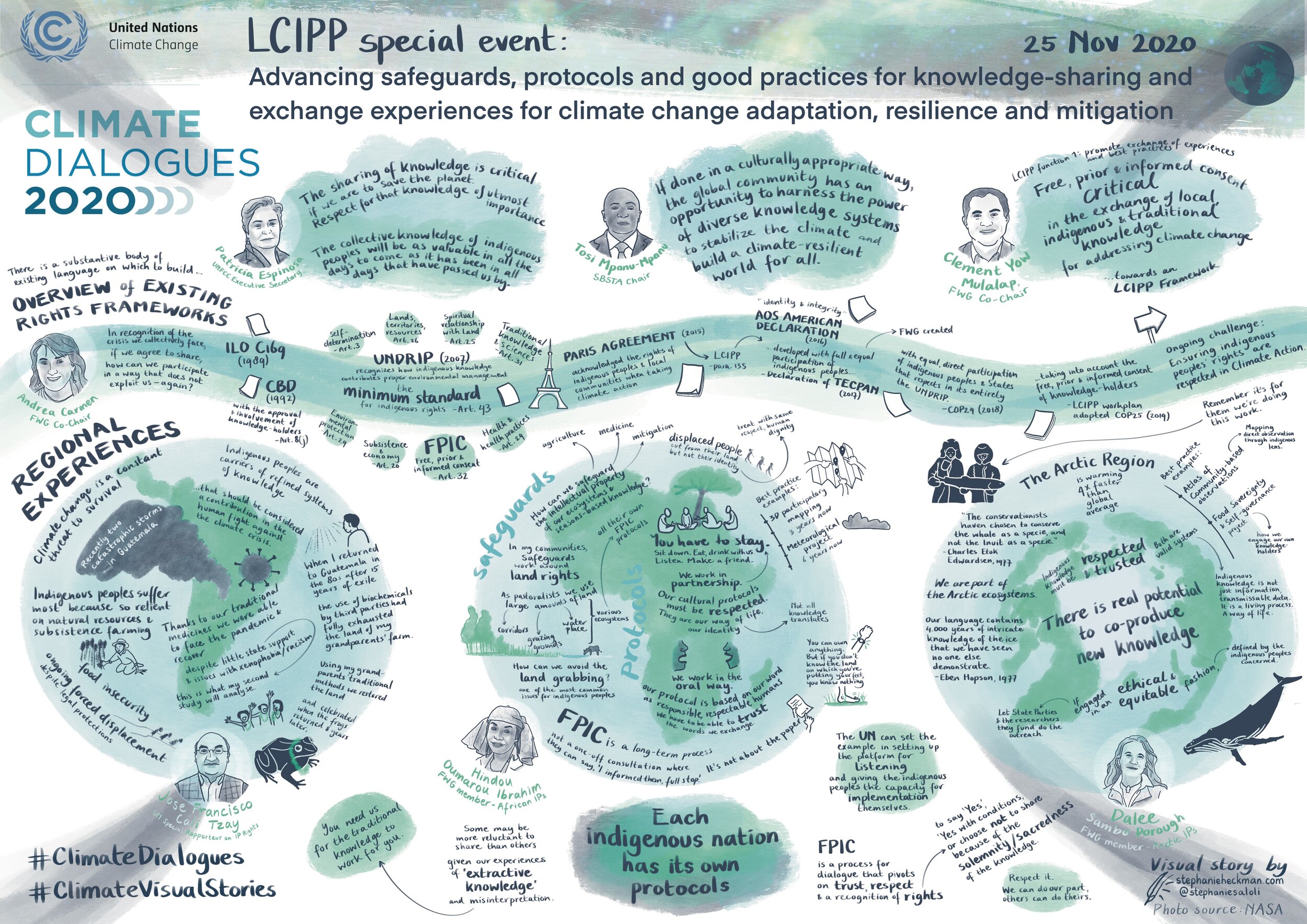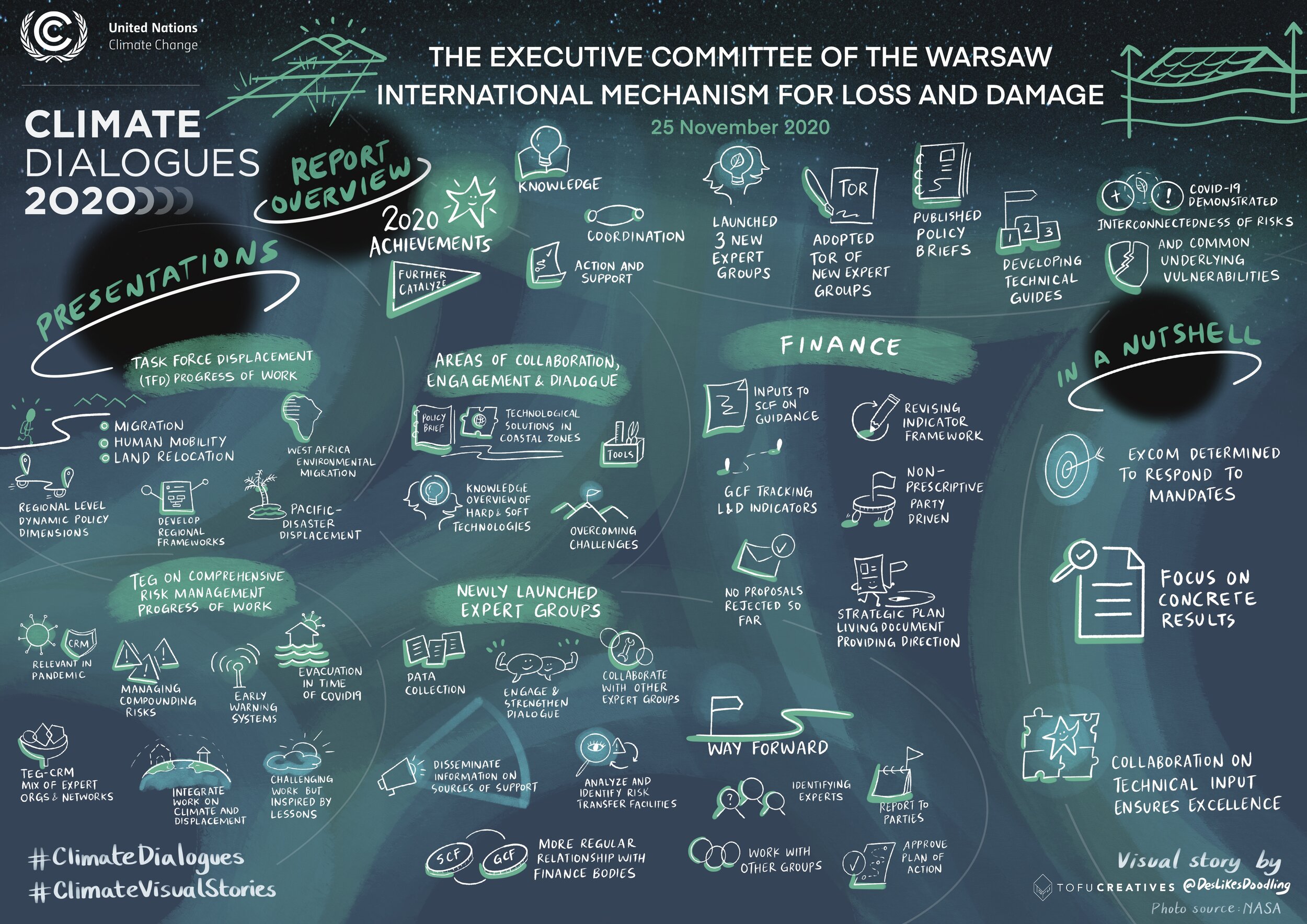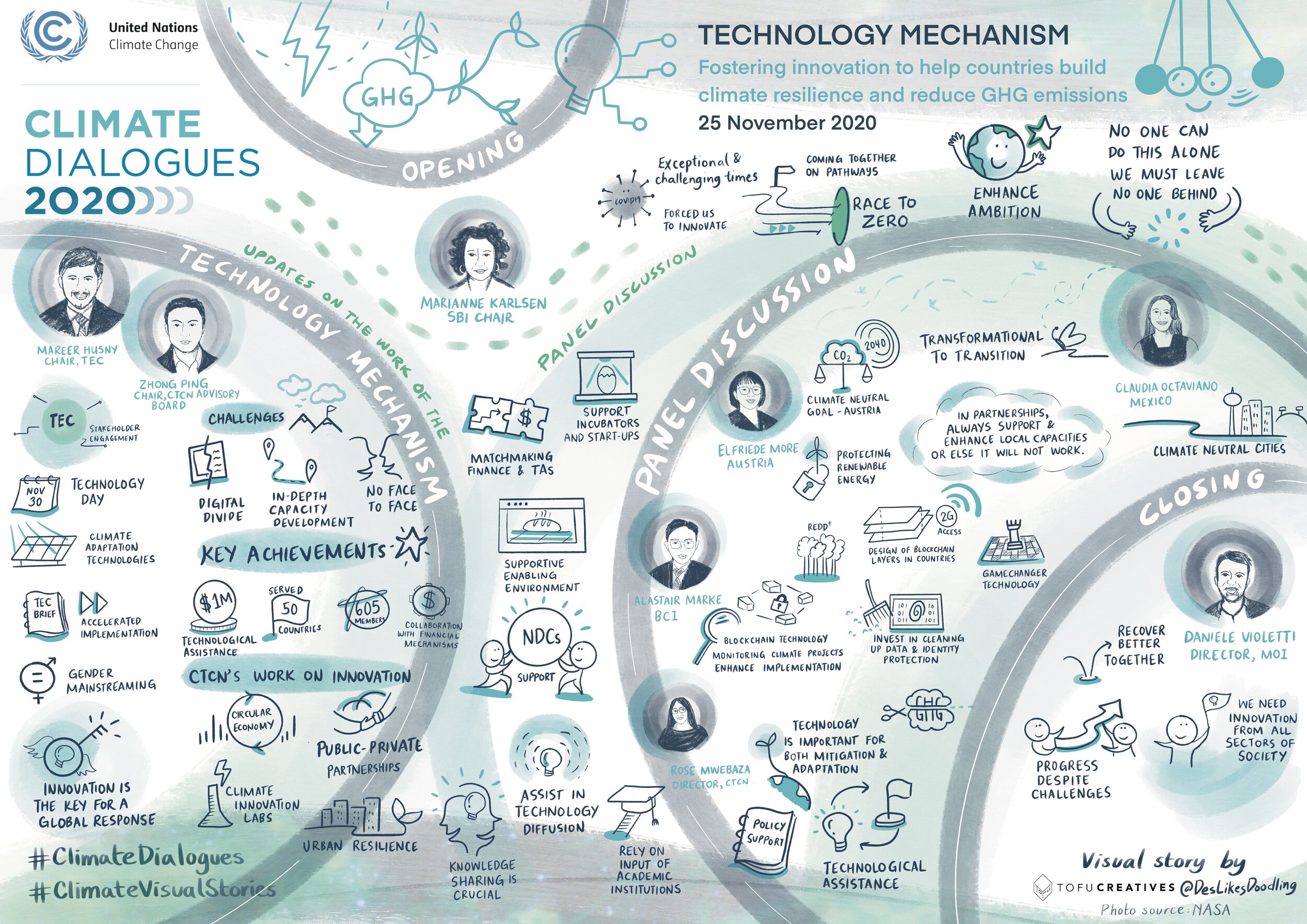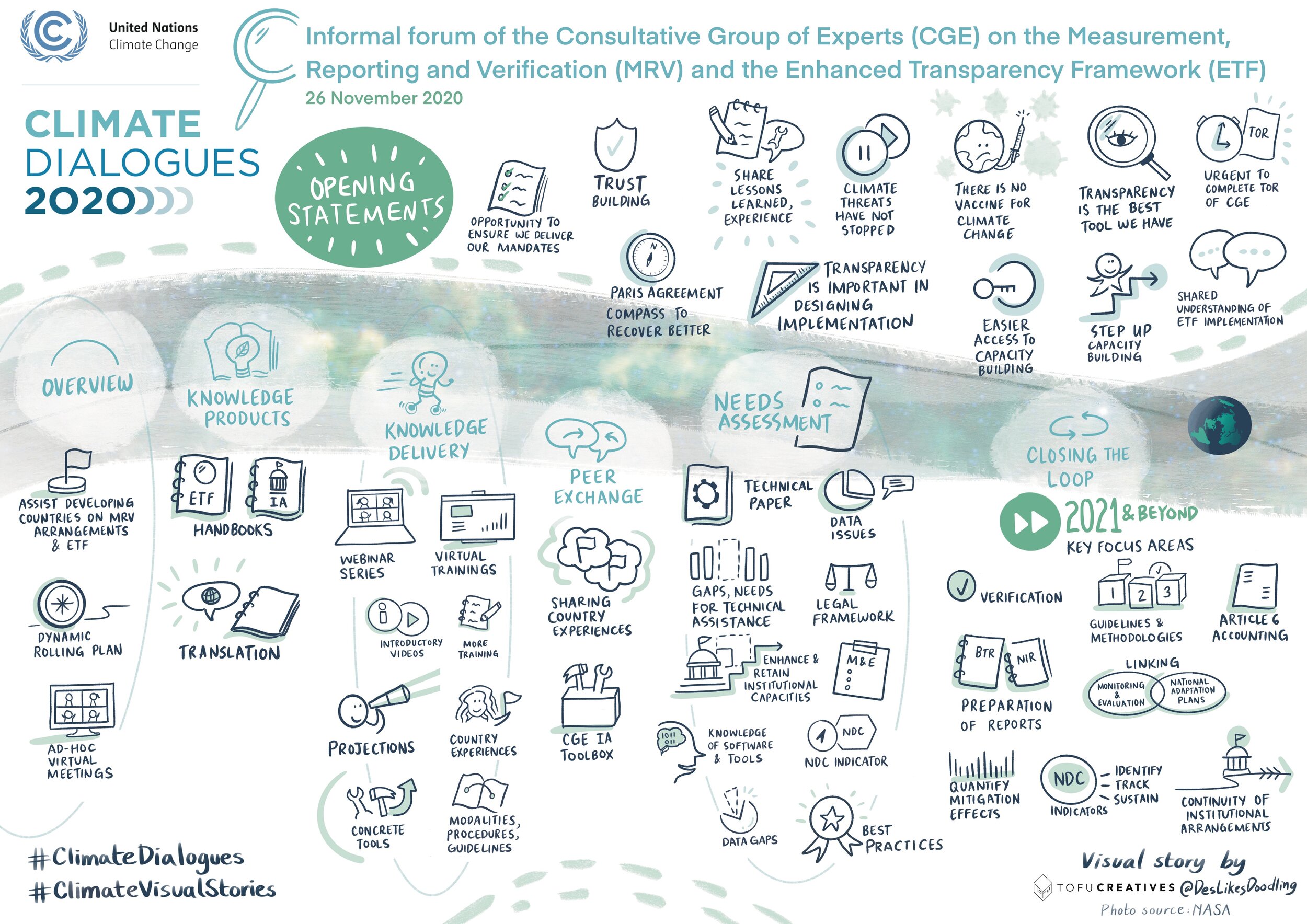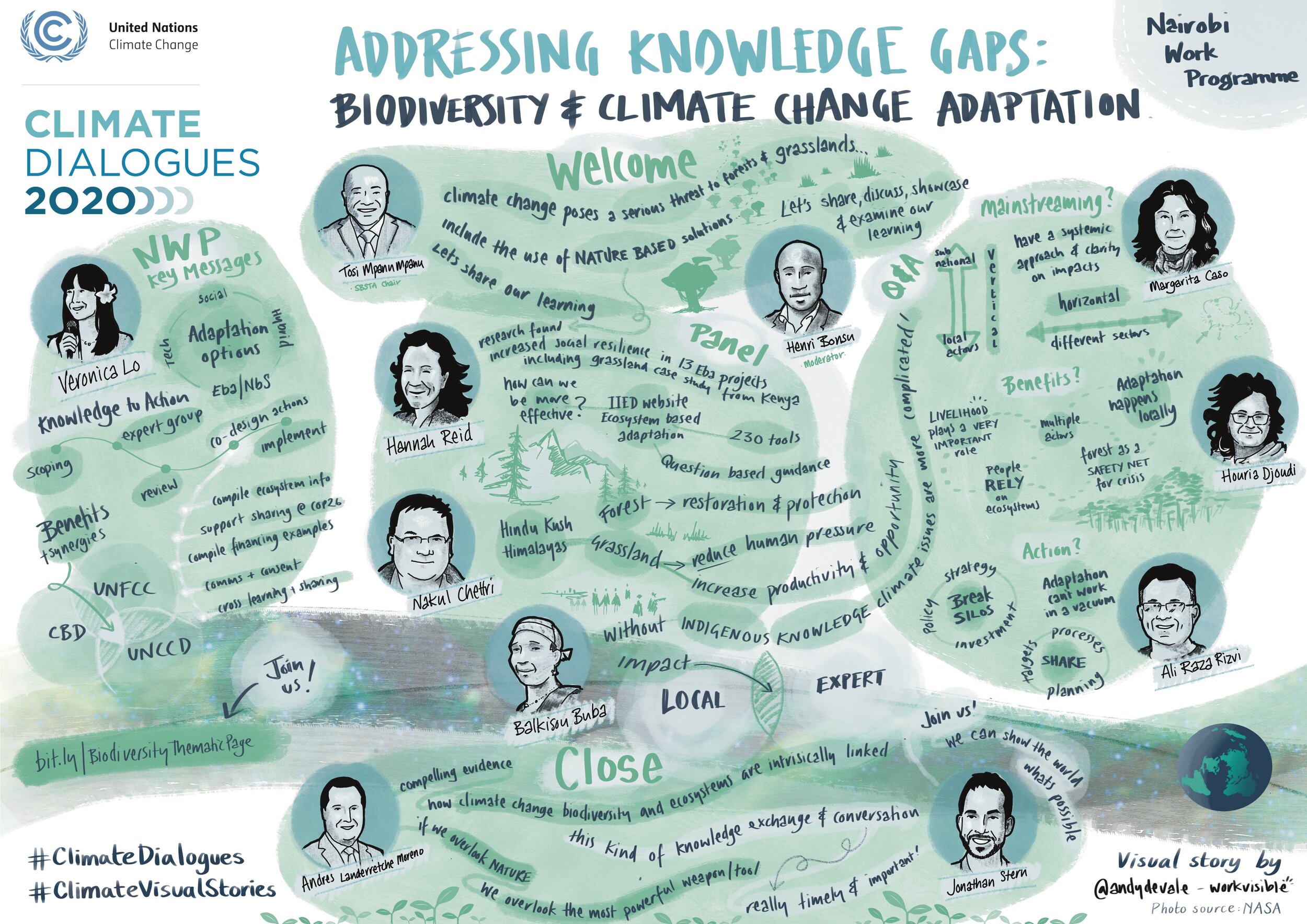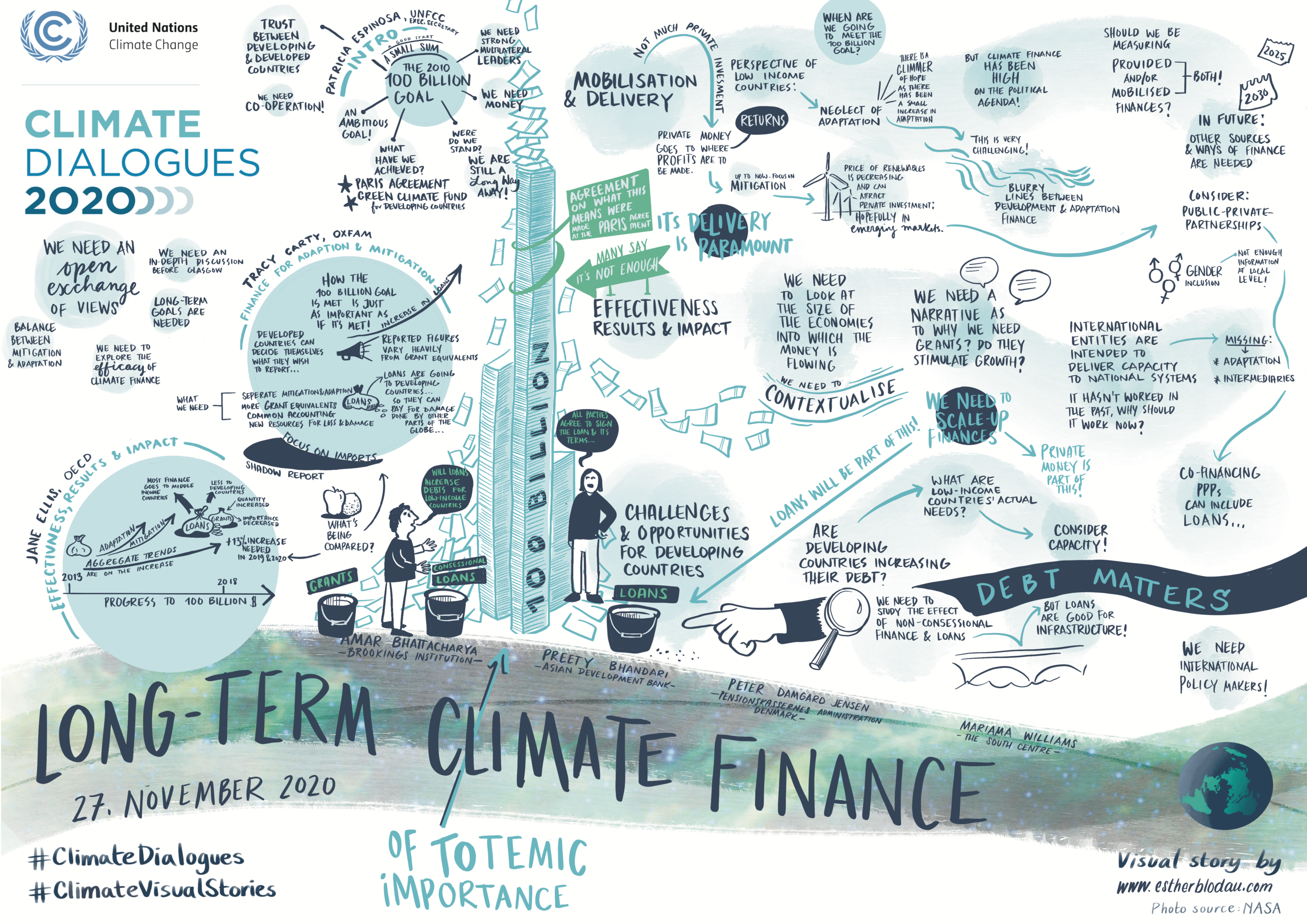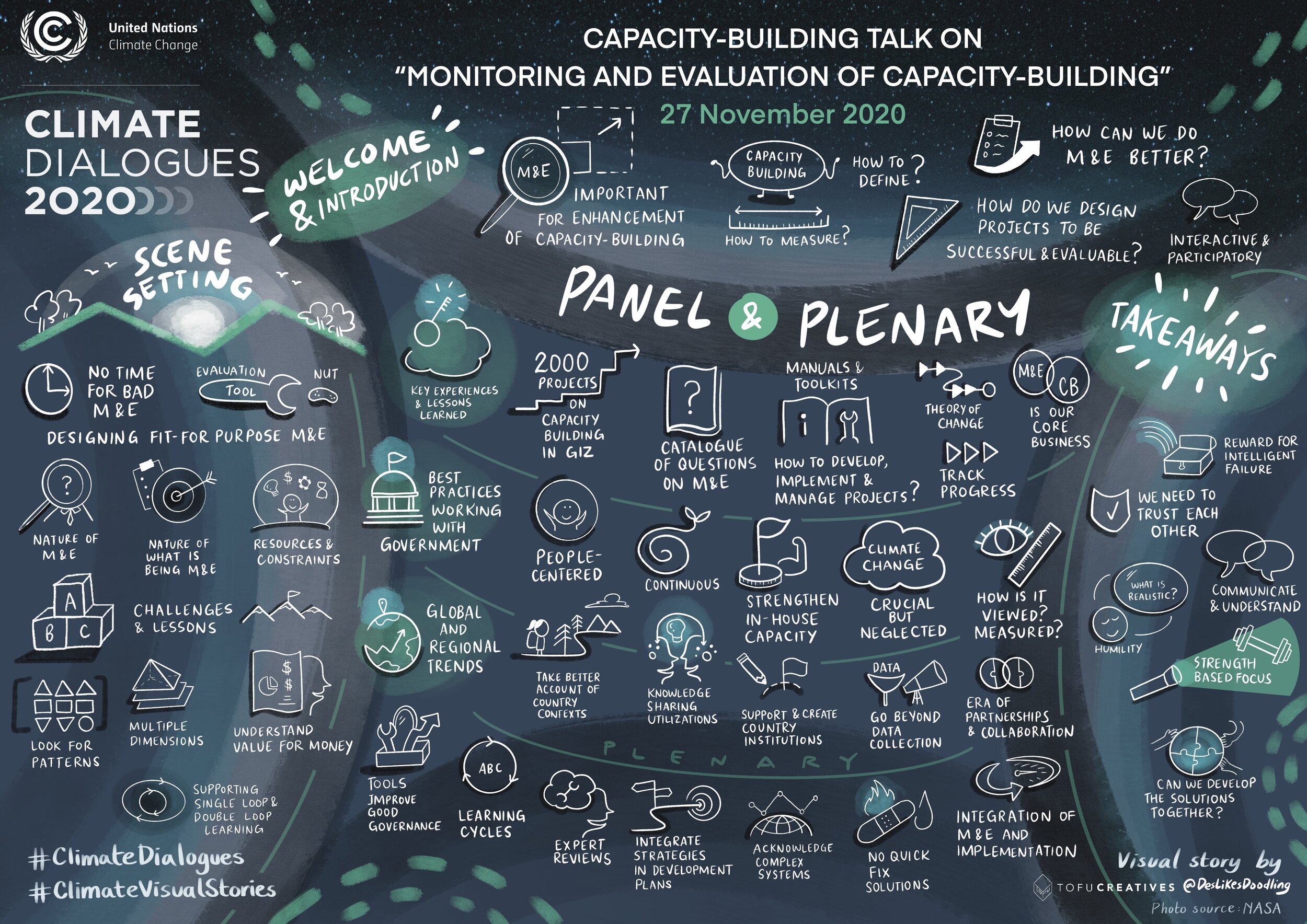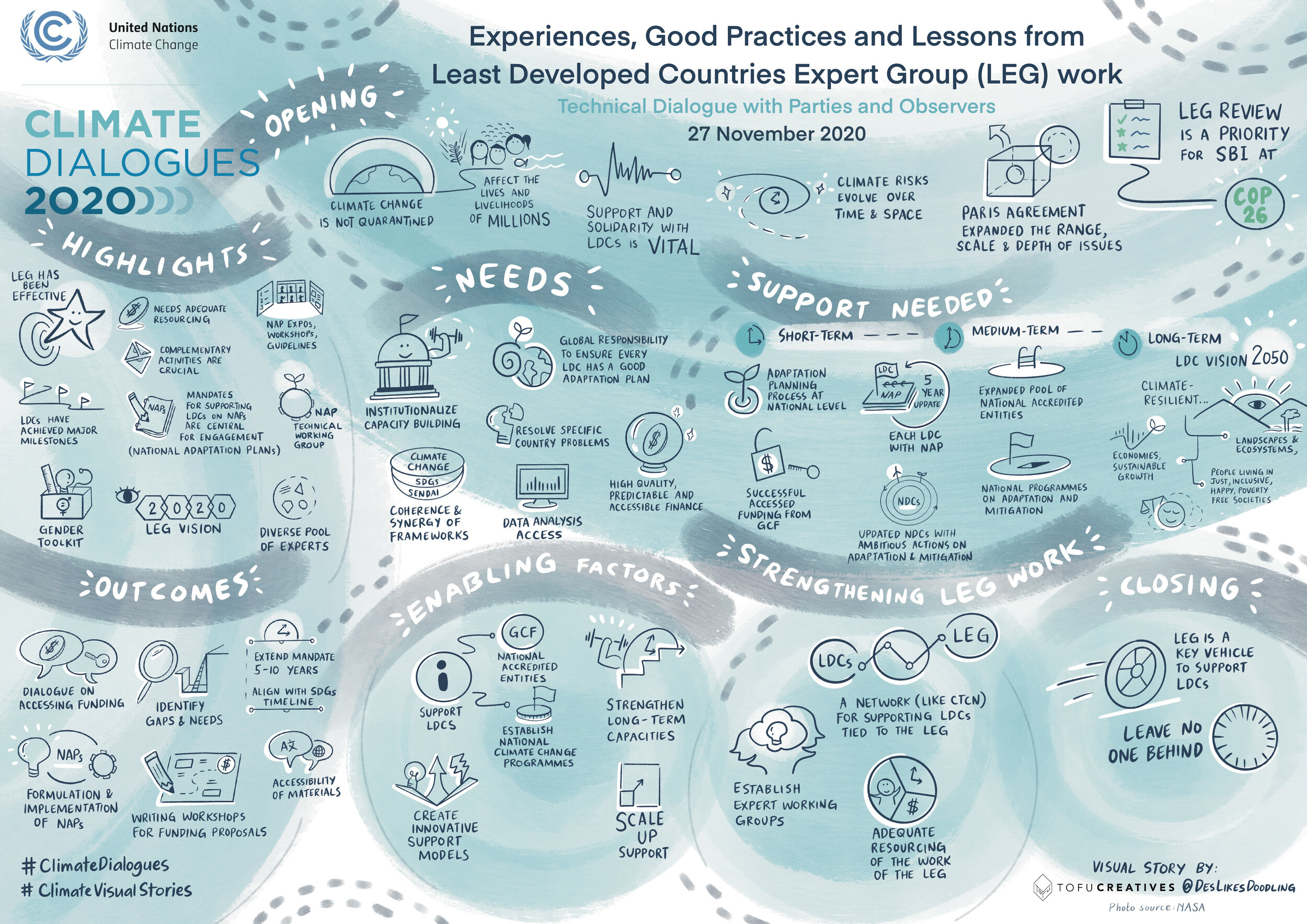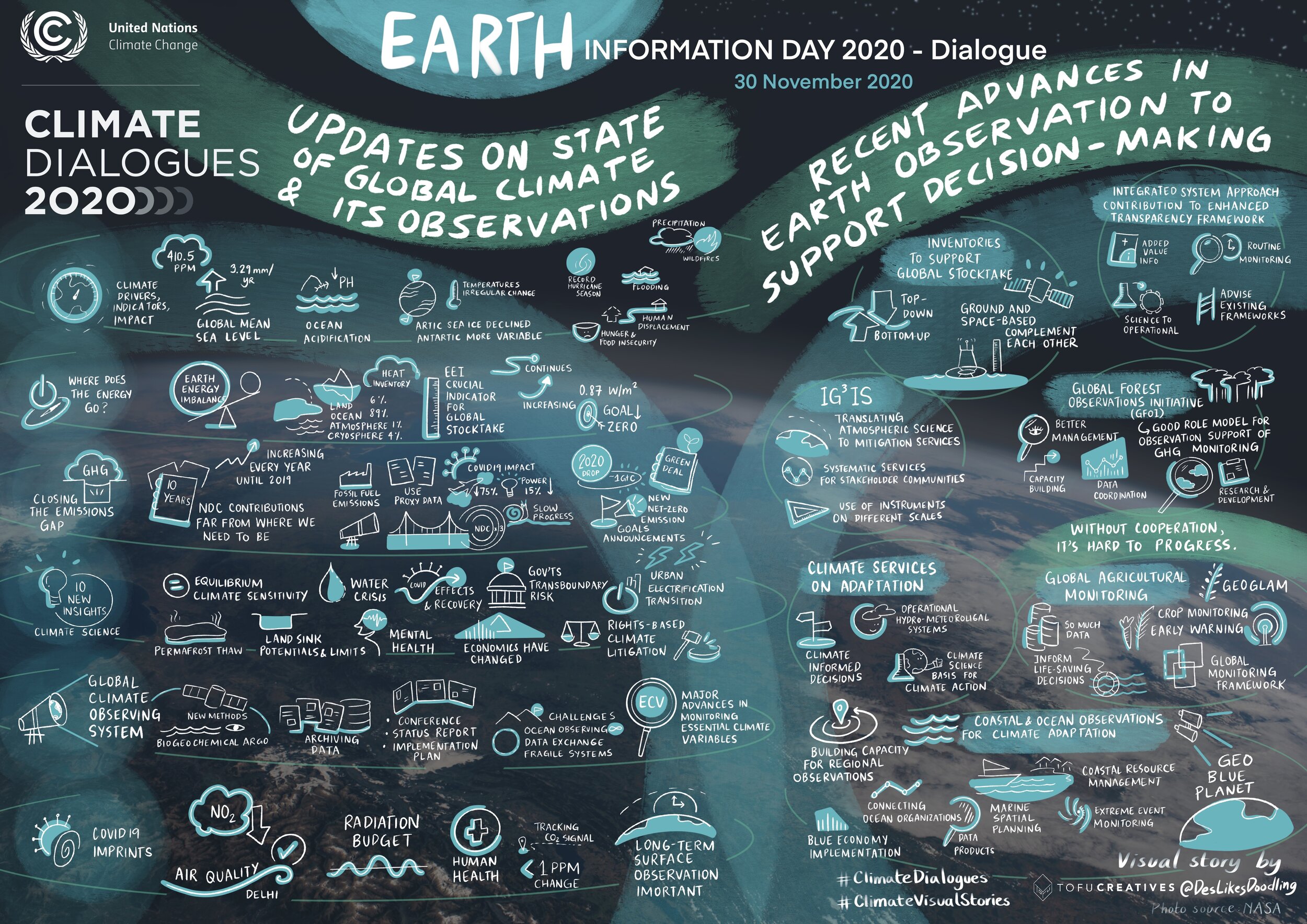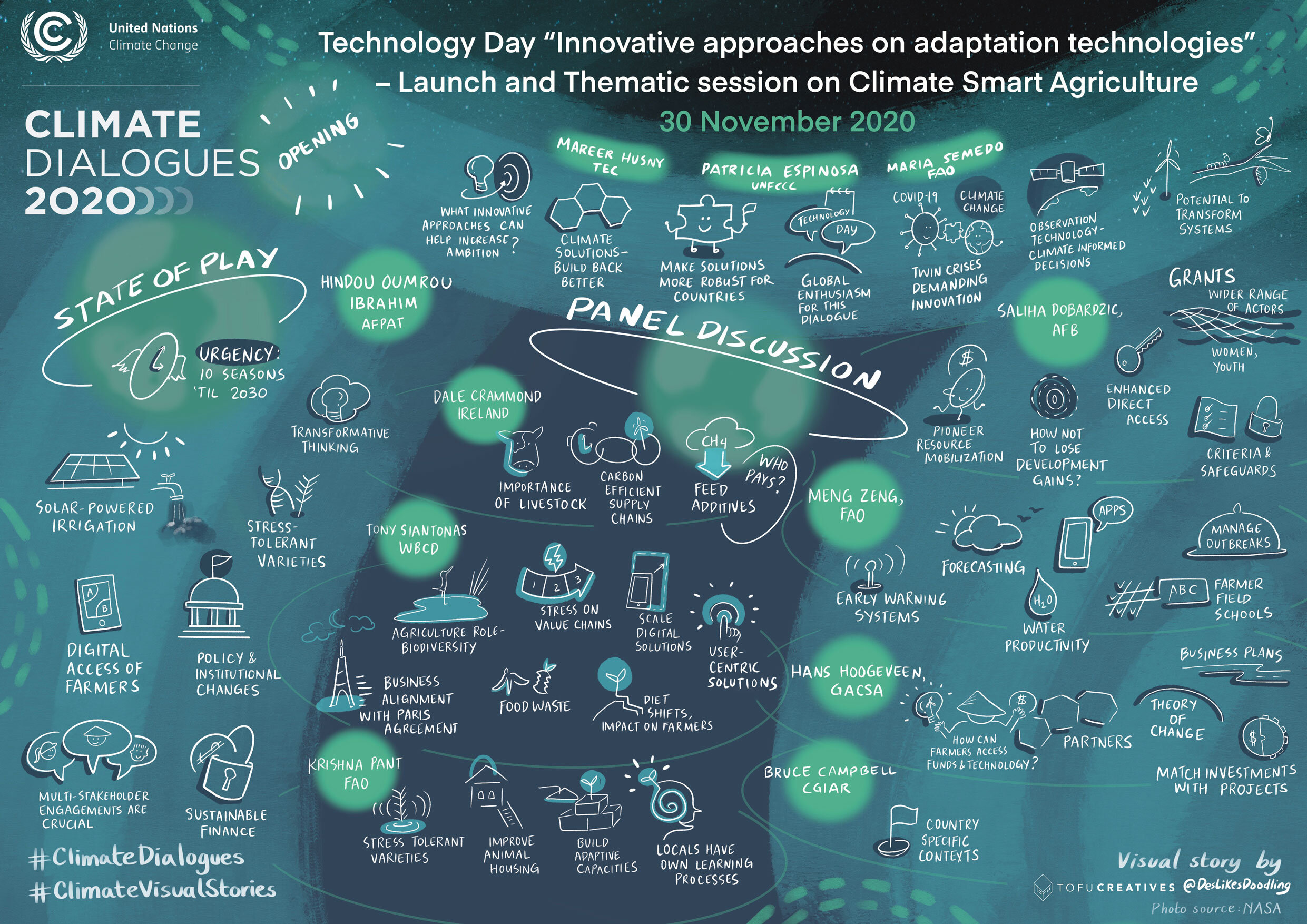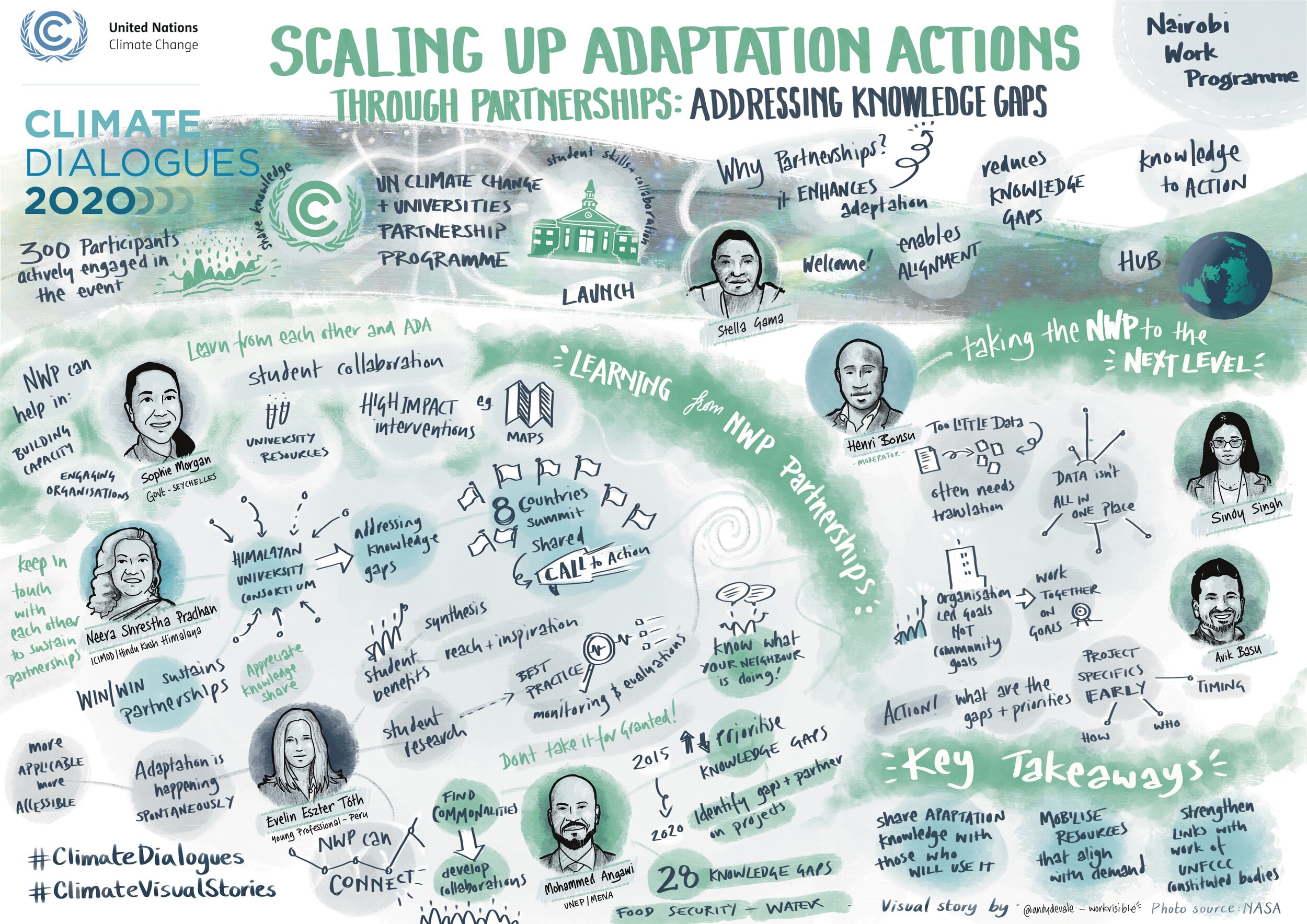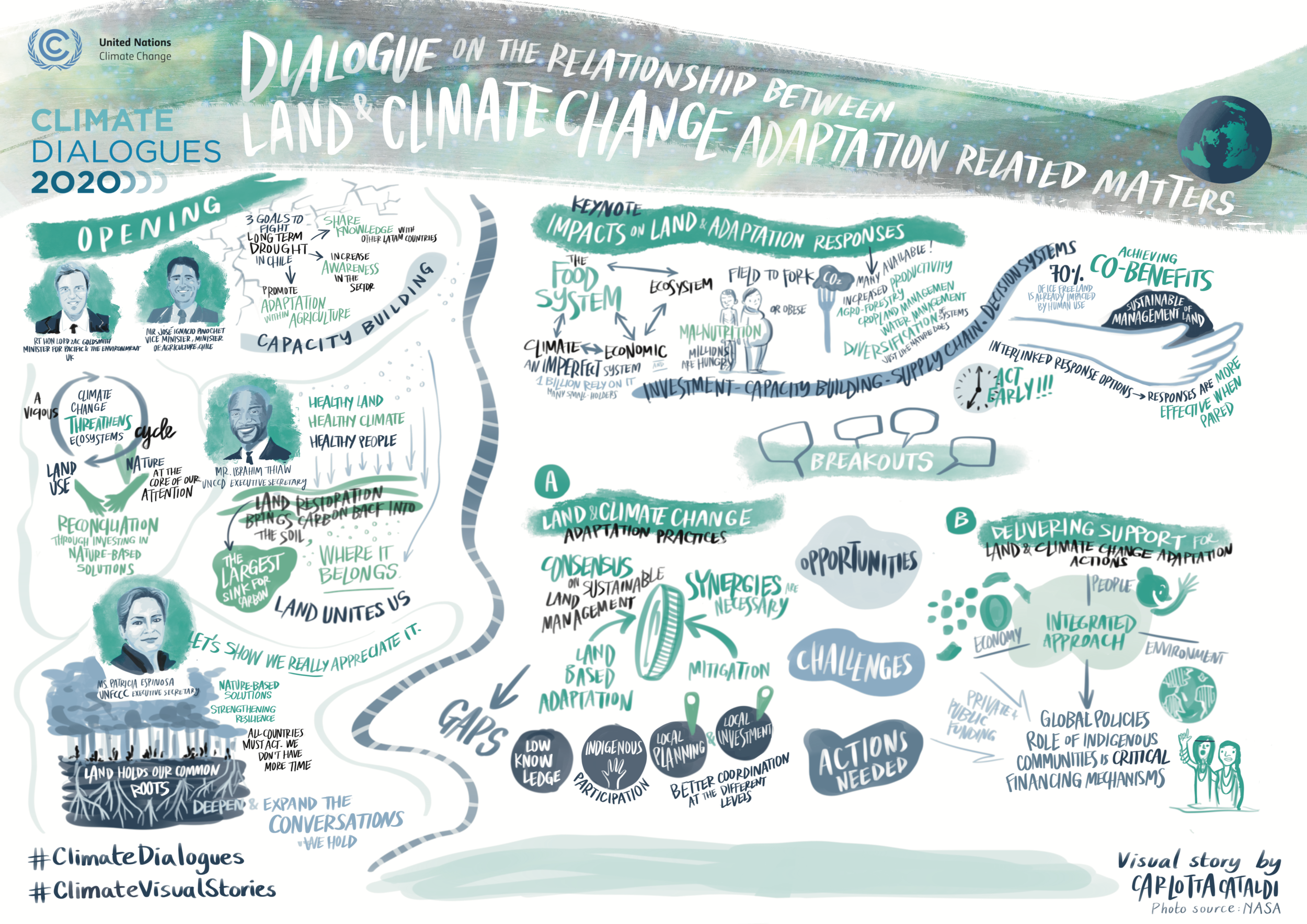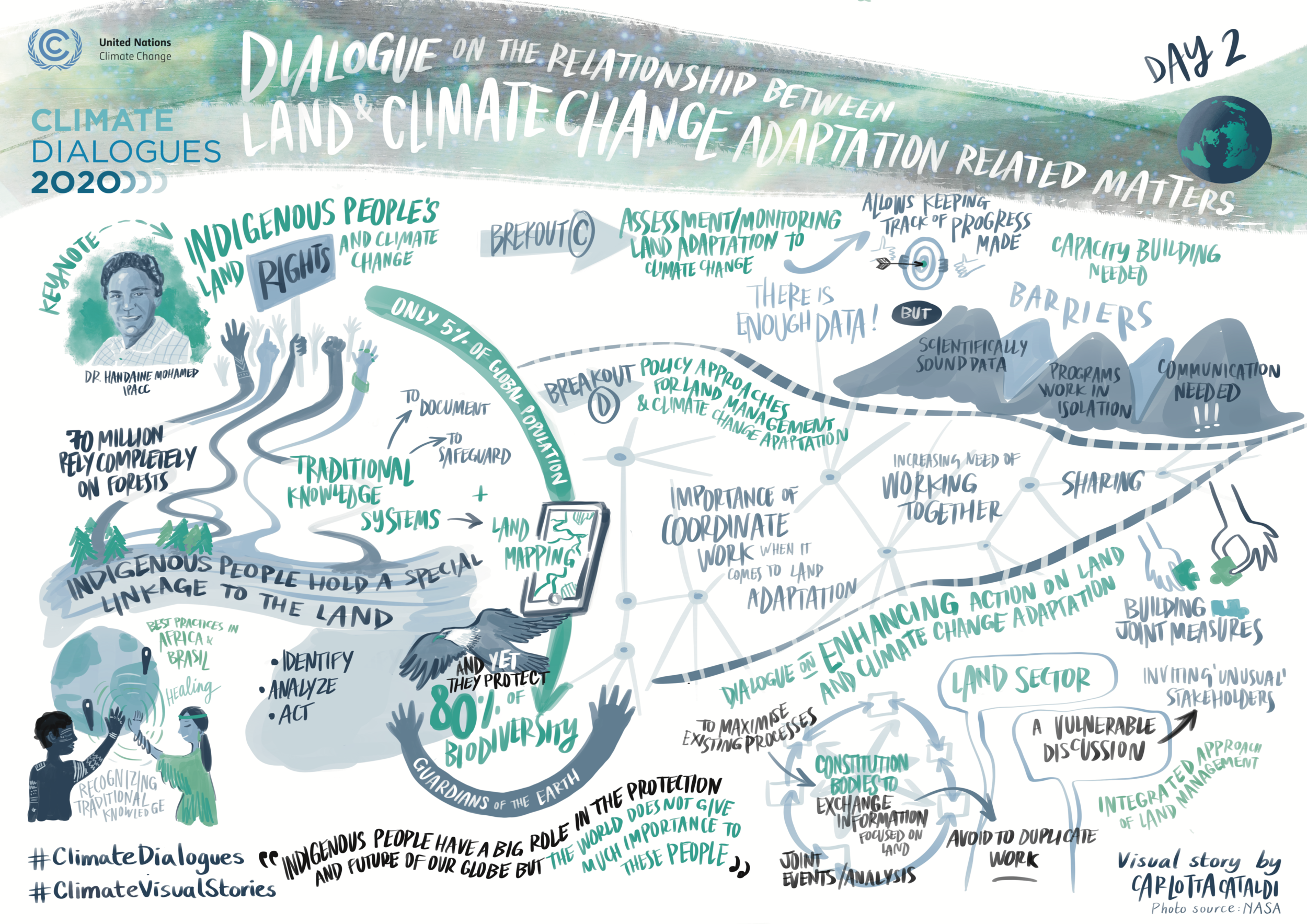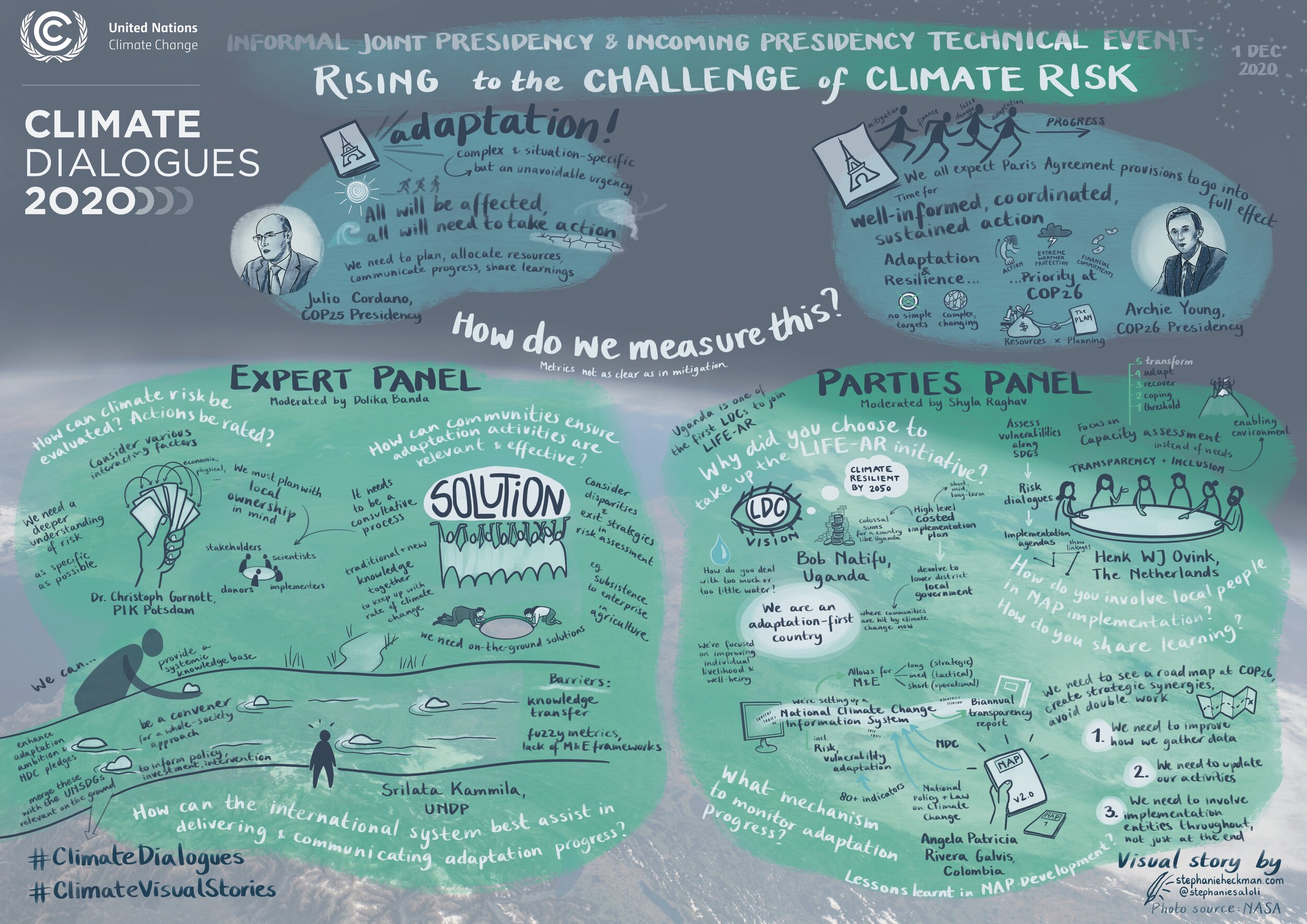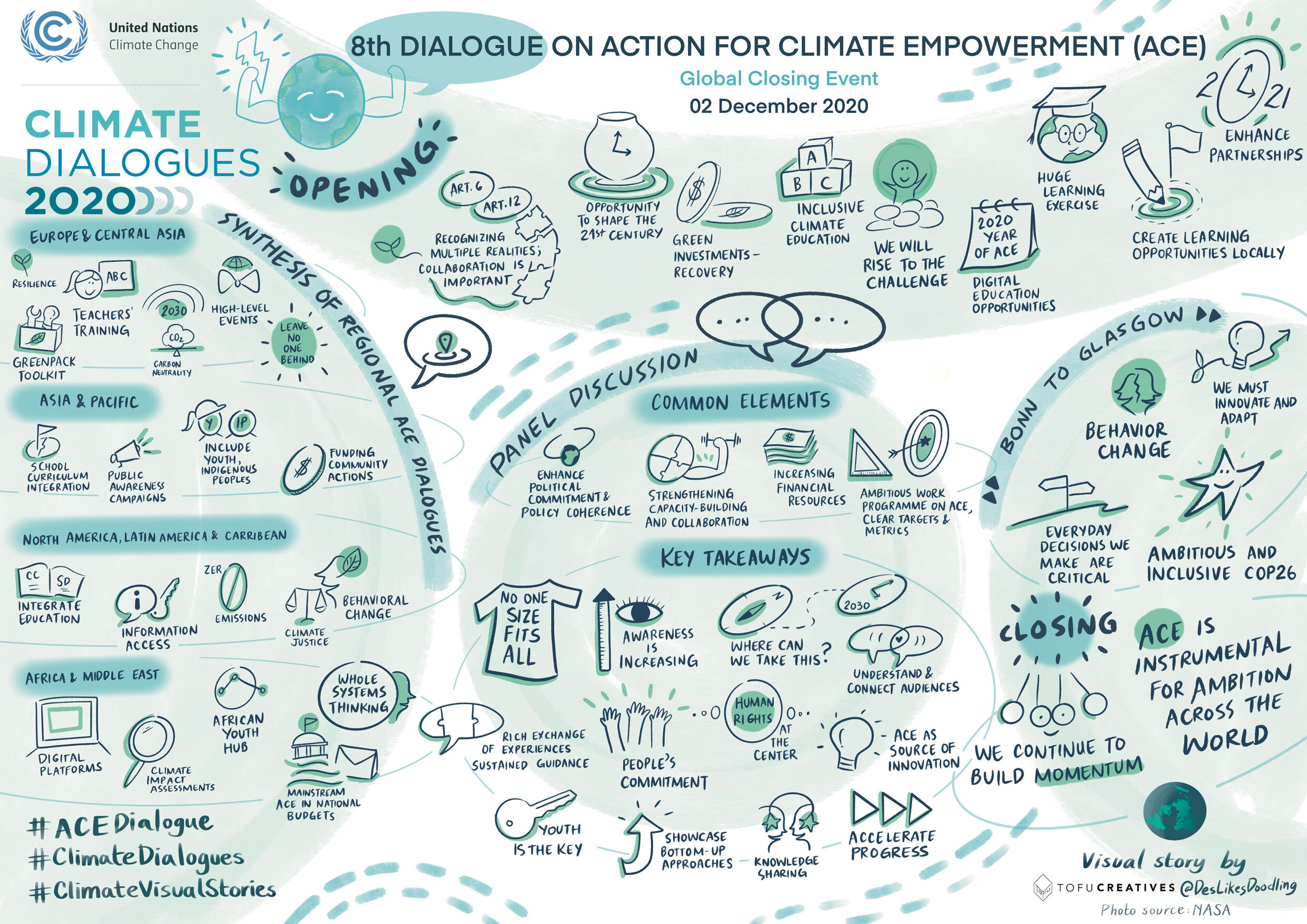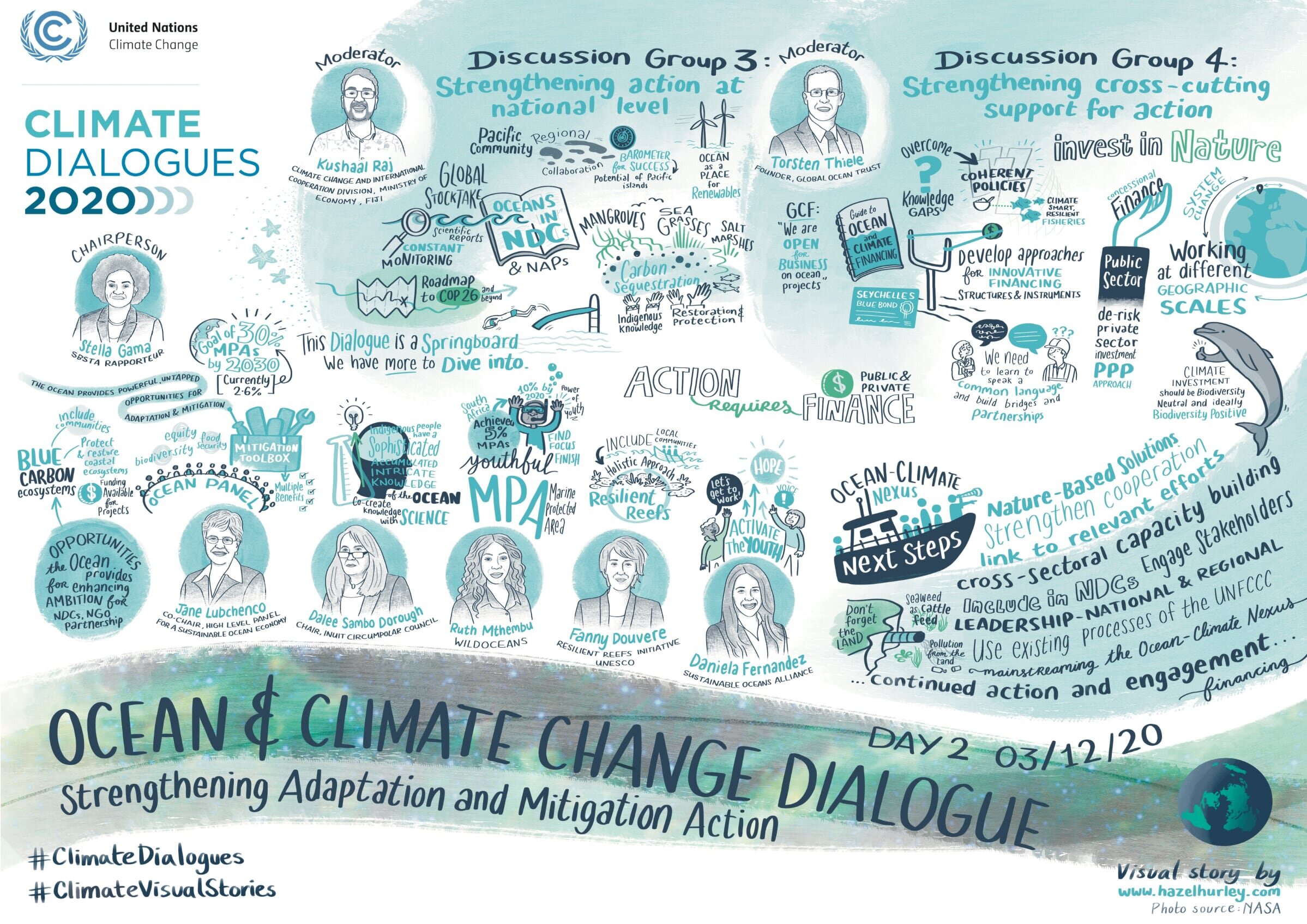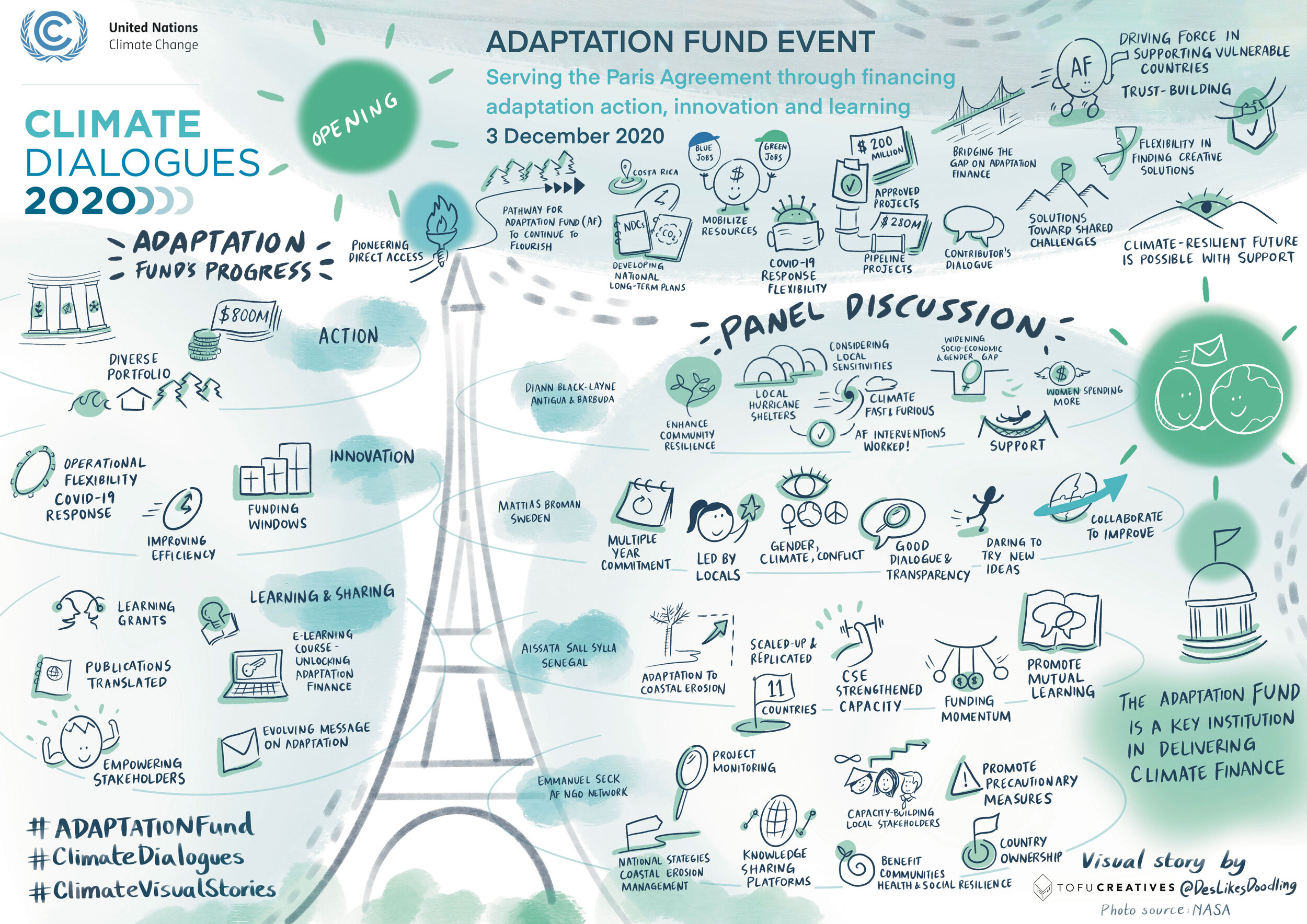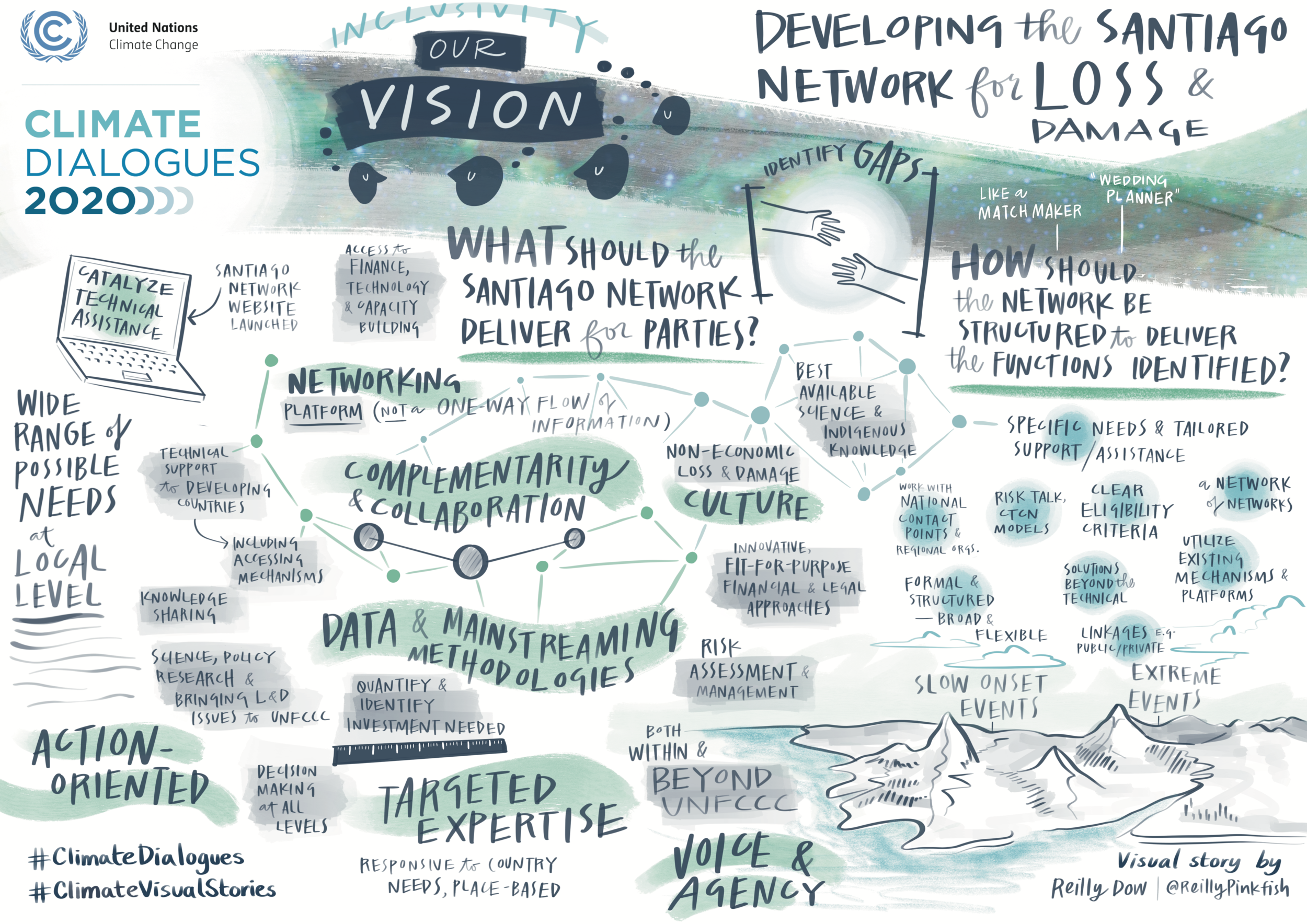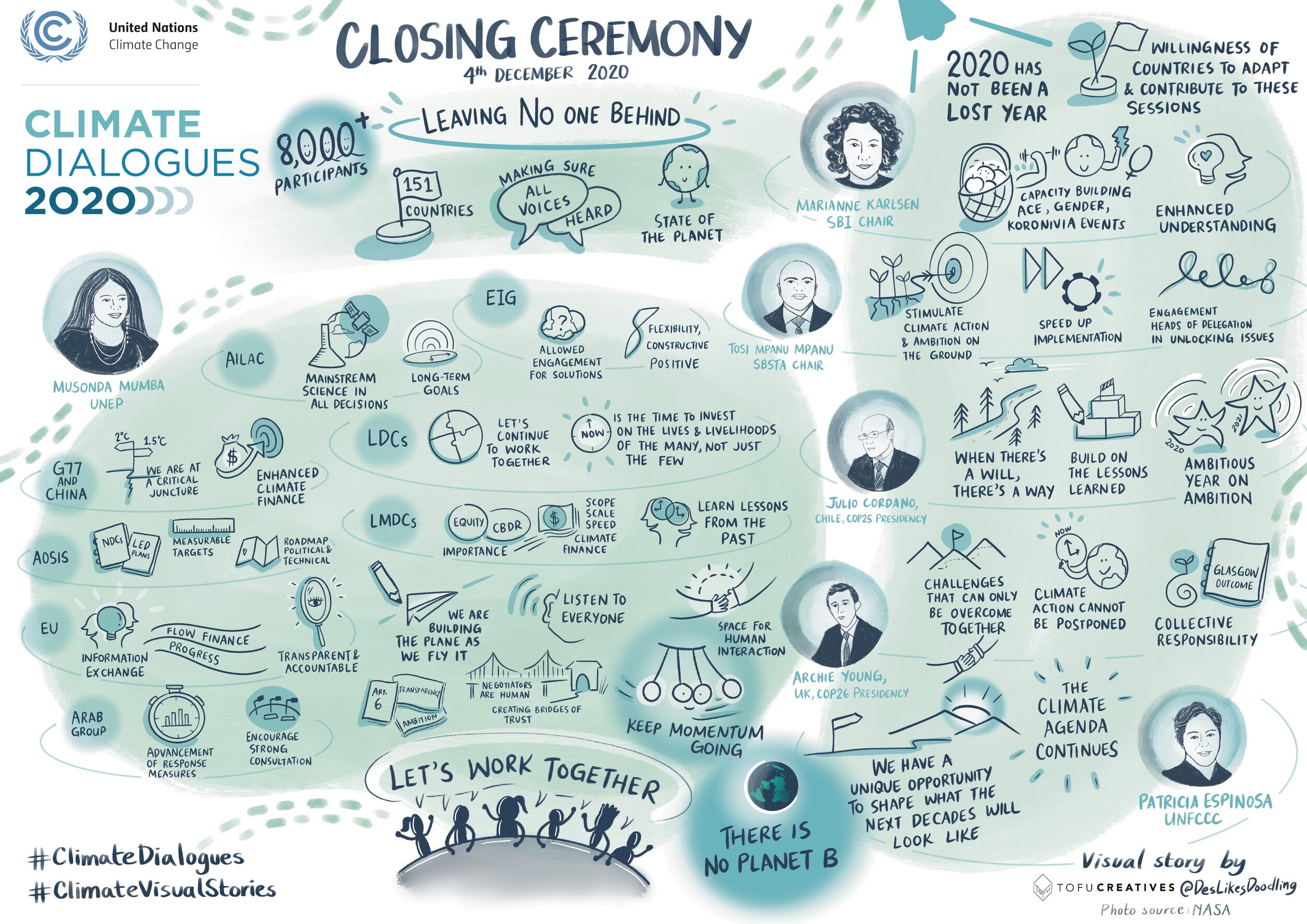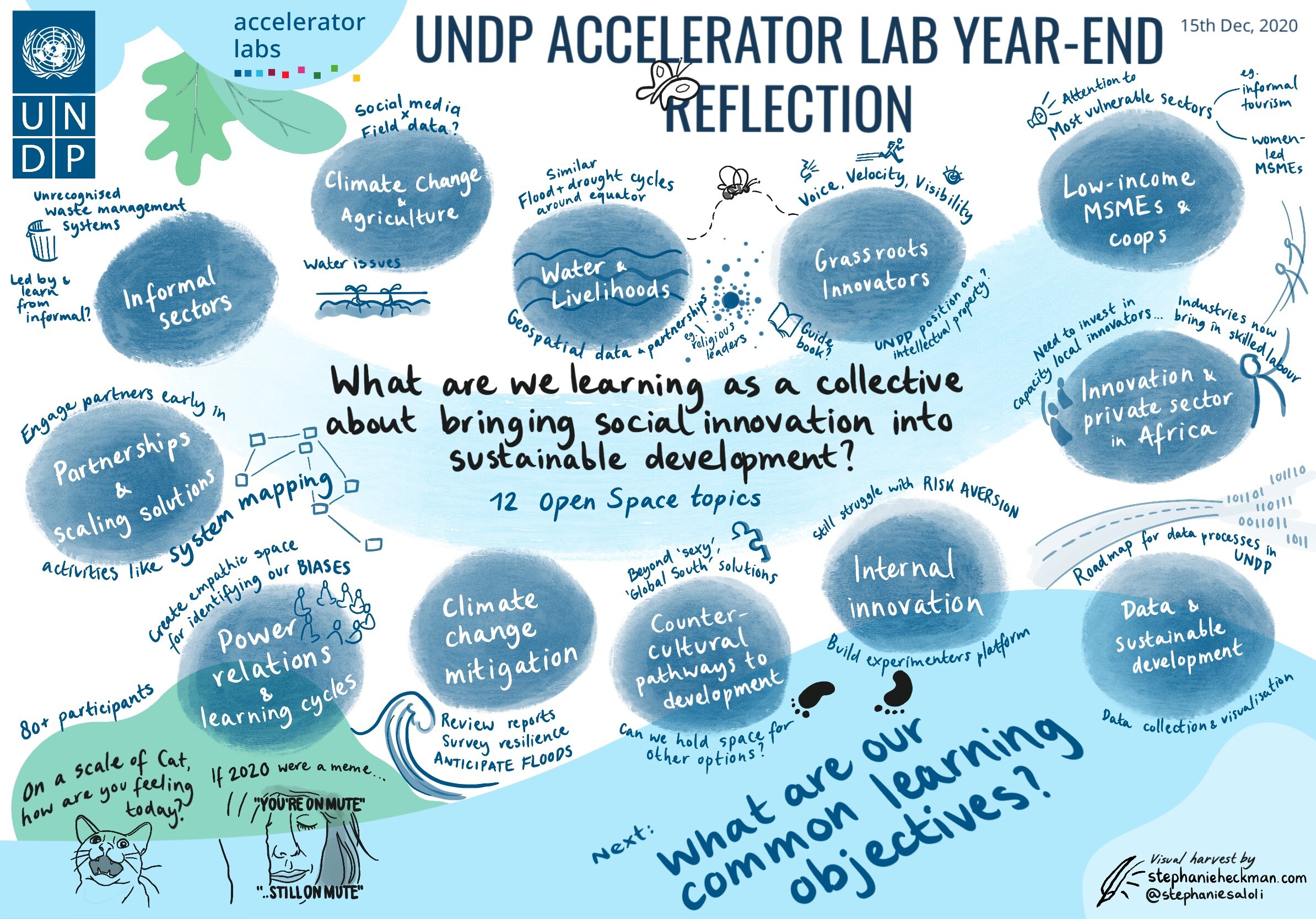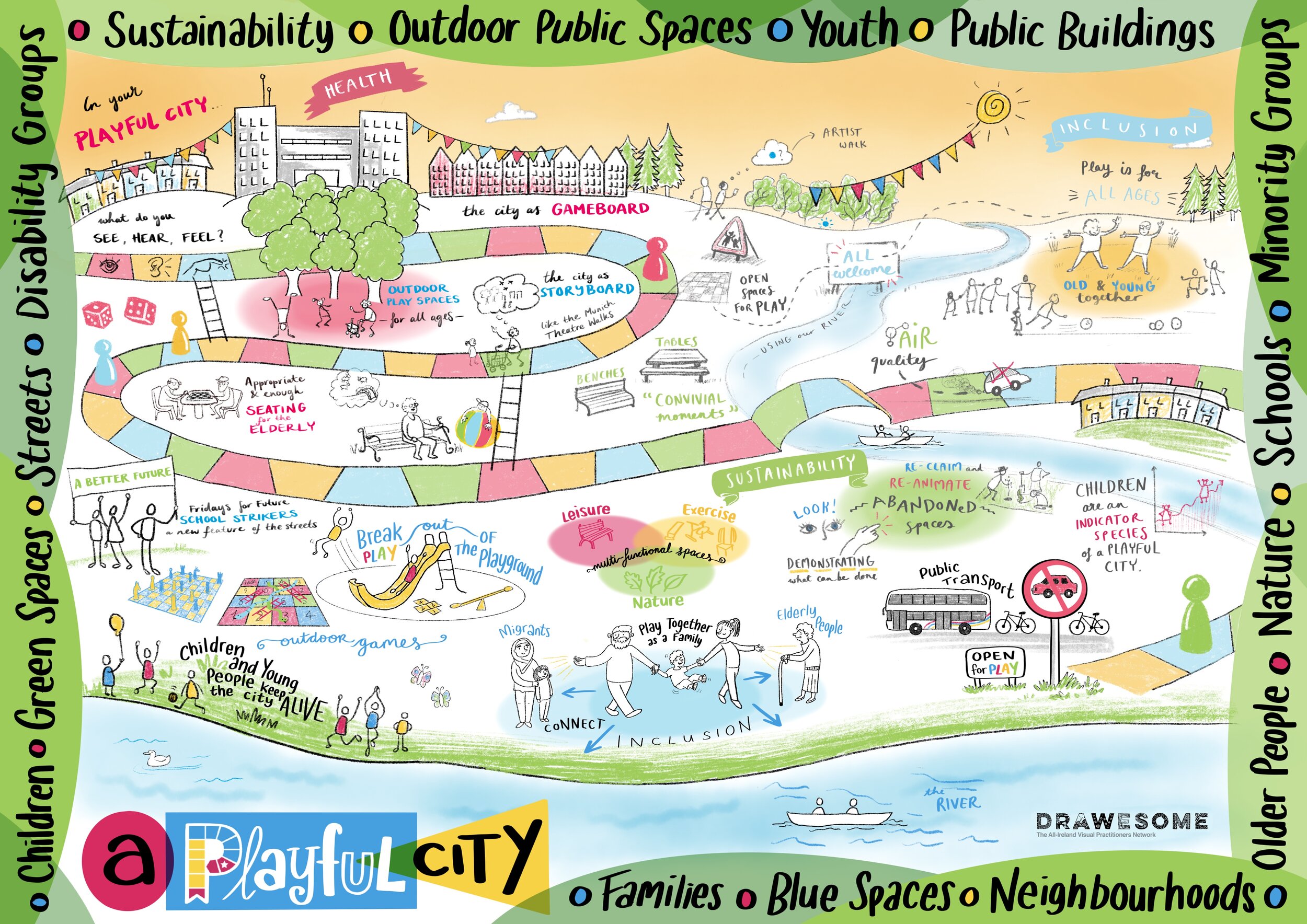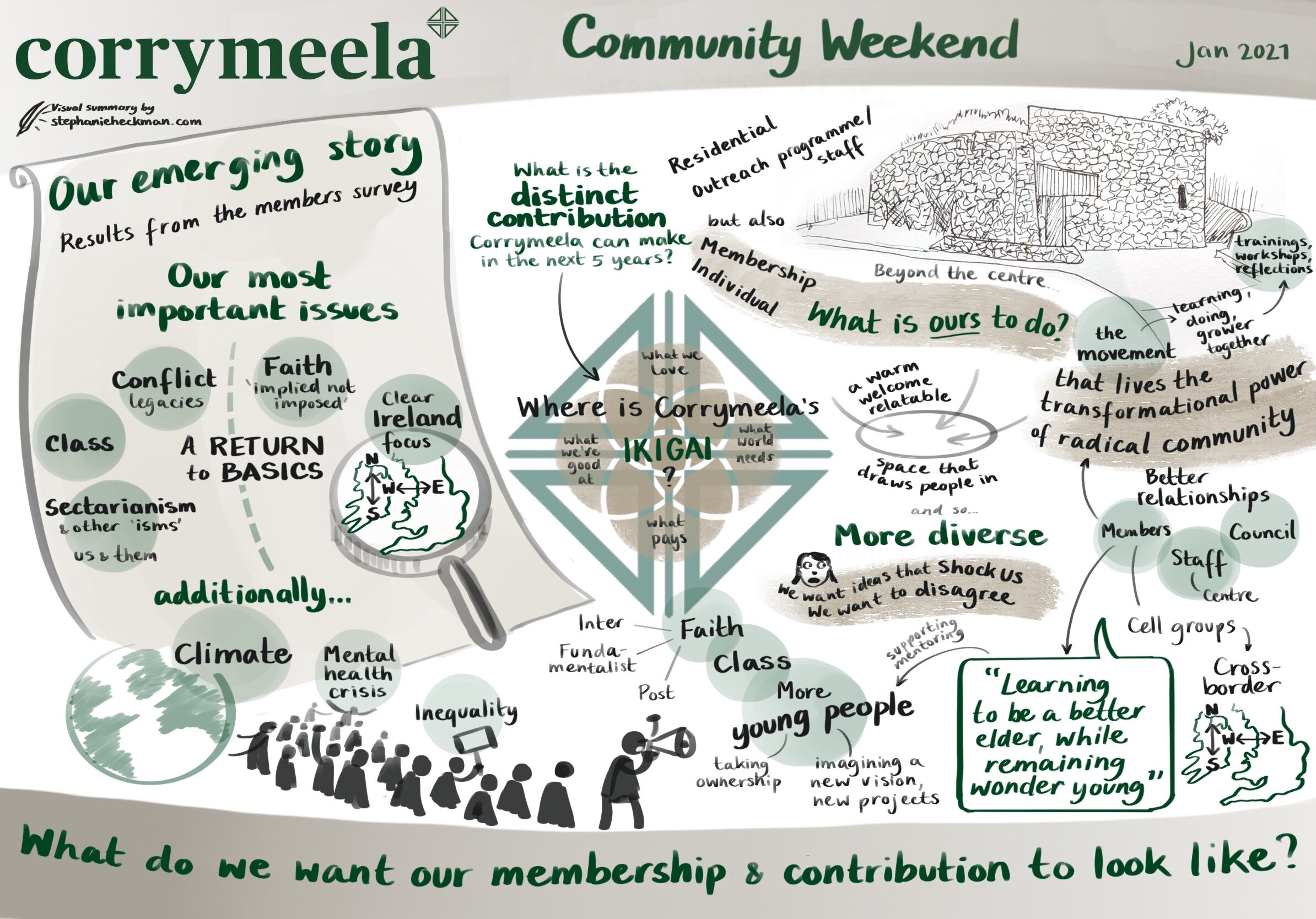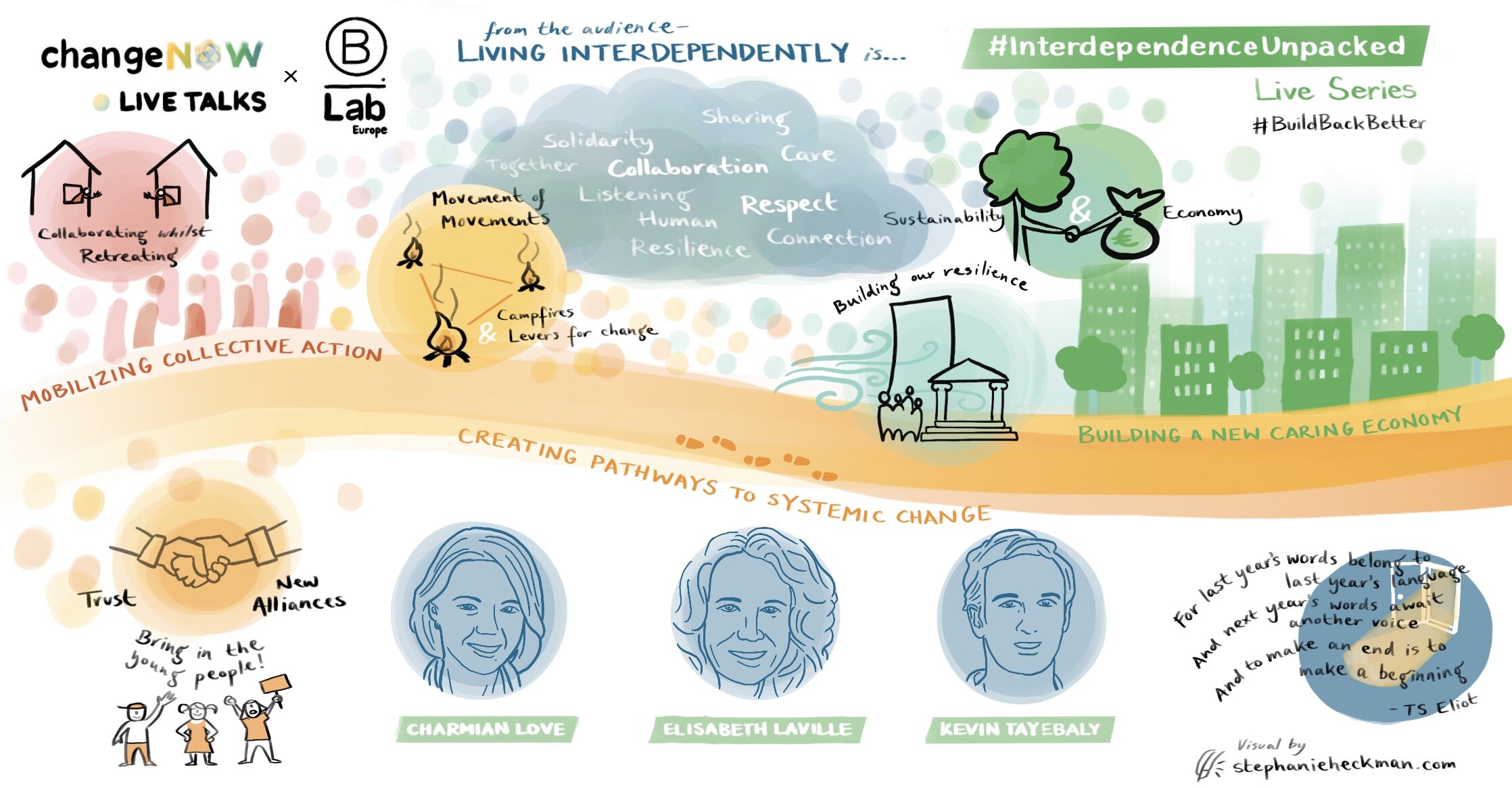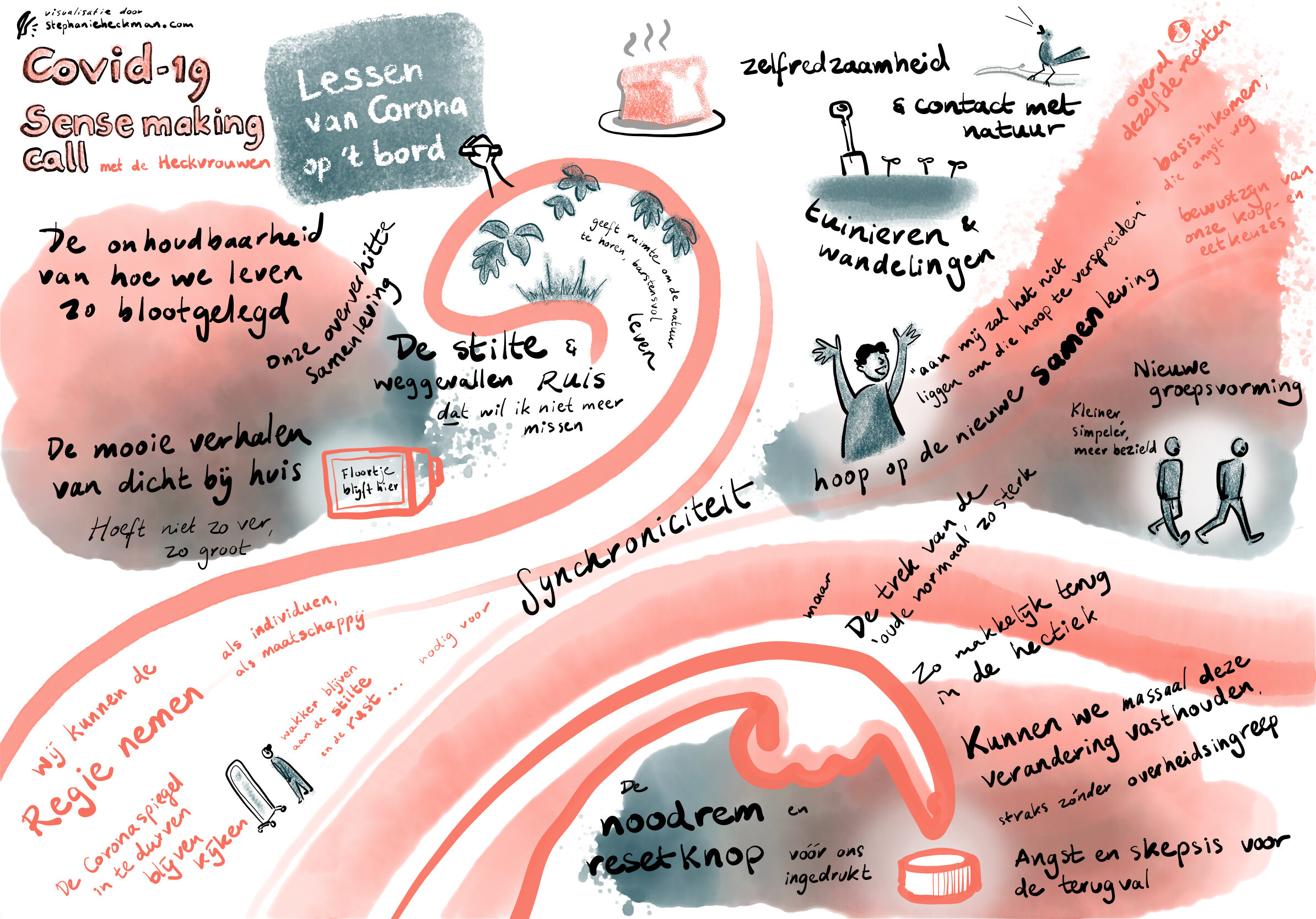Behind the Scenes – Digital graphic recording for the UNFCCC
Digital graphic recording - visually capturing remote collaboration
COVID-19 has thrown up many challenges, what with bringing our economy to a grinding halt and locking us all away from each other. But in tribute to humanity’s true character of resilience, creativity and innovation, COVID also heralded a collective opening of the mind to doing things differently and trying something new – such as using visual practice to improve remote collaboration. Graphic recording translates conversations into images. It is a tool for live note-taking and sense-making of dense content, acting as a parallel processing pathway for all those visual thinkers among us. Visual practitioners have been coming alongside conferences, trainings and meetings for decades, but now that people were confined to Zoom meetings, stripped of many of the benefits we took for granted in in-person communication, the value of visual practice has been hammered home to many people in a powerful way.
For me as a visual practitioner, the ‘great 2020 migration to digital’ precipitated by COVID-19 created many new possibilities and opened many doors. Among them, the doorway to the United Nations was opened to me. In this article I share the backstory of how I was commissioned, and, along with seven other visual practitioners, how we organised the visual storytelling for the UN Climate Dialogues 2020.
A peek behind the scenes at the graphic recording of the UNFCCC Climate Dialogues opening ceremony, the first event to kick off two weeks of multilateral conversations about global climate action.
Getting the job
If there’s one thing I’ve learnt from self-employment over the last few years, it is that putting yourself out there pays off. As a sole trader I have learnt that the foundation of all my work is relationships: investing in my client relations until they become mutually valued and trusted, and may go on to bear fruit I may not expect in the form of referrals or new projects. Secondly, I’ve found that plotting out strategic direction and setting financial as well as client/project-oriented targets on a yearly basis brings real focus to my work. As my own manager, I need to set course and correct drift. And as my own sole employee, I also need to put in the work to deliver on my annual targets. With this ‘internalised team’, I’ve met 80% of my ‘BHAGs’ (Big Hairy Audacious Goals, or stretch goals) over the past two business year cycles.
January 2020: Setting the intention - aiming high!
For 2020, I wanted both to scale up my work and shift it intentionally towards supporting sustainable development efforts. When I discovered in January that the next UN climate summit, COP26, was to be held in Glasgow, one of my 2020 stretch goals became to rally a group of visual practitioners and find a way to go to Glasgow to visually support the summit. It seemed like perfect timing: apart from my involvement with the Irish visual practitioners’ network, Drawesome, I was also talking to the nascent Scottish network Scotviz, and was about to meet my first English and Welsh colleagues at a course in Oxfordshire. This was the most extraordinary opportunity to contribute meaningfully as a UK-based visual practitioner to a local event of such huge global importance to our planet. And as so many in this field are ideals-driven in our work, what a job this would be to convene a crew of UK-based practitioners around!
I reached out to Scotviz, whose nation was to be hosting COP26, and began trying to make inroads into the labyrinthine UN universe. Who even organises COPs (Conference of the Parties; the UN Climate Change Conference)? Is it ‘the UN’? Is it the host country, the UK in this case? I reached out to my networks for leads and warm introductions, reached out cold to various UN organisations and UK government offices and officials, and I did a couple of ‘freebie’ graphic recordings in pilot collaborations with UN-affiliated bodies. Then COVID and lockdown hit, COP26 in Glasgow was postponed by a year, and I put the idea to bed for the time being.
The graphic recording from June 2020, done for the Local Communities and Indigenous Peoples Platform, that circulated and introduced me to the UNFCCC, and the UNFCCC to visual practice.
Unbeknownst to me, however, one of my ‘introductory’ graphic recordings was meanwhile making its way through the UN grapevine and landed with exactly the right people: the team within the UNFCCC responsible for organising the Climate Dialogues – a two-week online event in lieu of COP26, aimed at keeping momentum on global climate action going (the UNFCCC – the UN Climate Secretariat – organise the COPs, it turned out). Seemingly out of the blue, they got in touch in September for visual support for a selection of their sessions, and gave me the green light to source some colleagues to help out. Putting myself out there, building relationships, and focus on the stretch goal were paying off.
Leading an eight-person visual practice team
The contract for ‘visual storytelling’ at the UNFCCC Climate Dialogues was for 26 events, split equally between with me and a design agency called Tofu Creatives. So the contractual preparations, negotiations of rates, and consultancy registration were done with us as contracted suppliers.
From there, I brought in five other colleagues from a mix of my networks - Hazel Hurley and Esther Blodau from my Irish Drawesome collective; Andy de Vale from the Scottish equivalent Scotviz; Carlotta Cataldi from the alumni network of my MSc degree MSLS; and Reilly Dow, from the alumni network of Kelvy Bird, whom I’d trained with the previous year.
Now it was on to the legwork. I had brought my colleagues in for graphic recording. To shield them from other subsidiary but necessary work and ensure an organised, streamlined approach, I had a week to prepare everything needed to bring my five colleagues up to speed with the broad brief, as well as the subtleties of intended tone, political sensitivities and the jargon and acronym-heavy language UN representatives and delegates are used to in their meetings. I was very much new in that space myself, but had had the head start of having done all that research earlier in the year. After our briefing calls and tech runs, we divided the 13 events assigned to us and I introduced my colleagues to their respective event teams. I kept liaising with my main contacts at the UNFCCC, but could now focus on the four sessions I’d be taking on myself.
At this point Desiree Llanos Dee and Nityalila Saulo, the ladies behind Tofu Creatives, came on board too, to make sure we could share a unified approach, and to join the fun – the more the merrier! We were now a single visual practitioners’ team totalling 8, working together rather remotely from the Philippines to Sweden, from Germany, Ireland and the UK to California and Mexico.
Andy de Vale’s sketch note of our first team call
I wanted to approach this project as a pilot for the real challenge: bringing a team of visual practitioners to COP26 in person, now a stretch goal for 2021. As such, I was making decisions and reflections based on how I’d want to do this if we were all together in a large conference setting. One of the mental models I used for this comes from the Embassy of the Earth methodology, developed over the years by my uncle, Frank Heckman. In participative design, he differentiates between world space, work space, sacred space and shared space (which I call tribe space, inspired by Holacracy’s four types of meetings). To invite full ownership from all participants (in this case, my visual practice team) into a project, different content and engagement styles belong in these different spaces. In physical gatherings, these would be physical spaces, from a desk to drinks in the pub after work. Here, they would have to be different virtual spaces. But mostly, they are different head spaces, different ways of engaging with the project, in order to bring to it your whole self.
These were some of the tasks on my to do list, and in what space they belonged:
The eve of the Opening Ceremony, one of the Climate Dialogues events I was to capture. Workplace set up, ready to roll!
Colour, canvas and brush standards for the visual practice team. Colour palette based on the brand guidelines of the UNFCCC Climate Dialogues.
Impressions from the UN Climate Dialogues
Operating on this scale and possible impact was an exciting debut for me, but it was a debut for the UNFCCC too, as they had never worked with visual practice for their events before. It was also a completely novel experience for most attendees. Because I had brought in additional support, the project for me became a combination of visual practice and event coordination, two strengths and passions of mine. So with this project I found myself doubly in my element, and under the banner of a cause I’m deeply committed to, to boot.
Listening and distilling into the visual world some of the conversations happening at the Climate Dialogues provided a unique glimpse into the effort of “trying to save our planet” at the highest international level, formulated in so many words by the UNFCCC Executive Secretary, Patricia Espinosa, herself. Beyond the dense technicality of many of the sessions, what stood out to me was this humanity revealed underneath the formal tone: seeing senior officials and panelists tuning into formal interventions 'underdressed' whilst out on a walk, or sitting in their own sitting rooms with all their cats and dogs and kids around, or even parked in their car during a rainstorm. The fact that all these humans, even at this high level, showed up driven by a deep care and commitment to the issues at hand gave me renewed hope in humanity’s willingness and capacity to right our wrongs.
"2020 has not been a lost year," commented the SBI (Subsidiary Body for Implementation) chair Marianne Karlsen in the closing ceremony, one of the most senior chairpersons in the UNFCCC. The Climate Dialogues gave me a real taste of the momentum building in the multilateral process towards COP26 in Glasgow next year. I keep my fingers crossed that it can be the breakthrough COP, moving from policy into action, that the world and planet needs it to be. And I keep my toes crossed that visual practice can play a supporting role in effecting that breakthrough; to ease, energise and amplify the communication required for global collaboration.
Here are all visual summaries we created as part of the Climate Dialogues 2020:
(See name of the artist in the signature bottom right on each graphic recording)
“Colleagues that have worked with you are very impressed by your fantastic artistic touch that you bring to our meetings. Thank you for your enthusiasm, tireless work, responsiveness, flexibility and excellent collaboration for this project!”
My deep thanks go out to my contacts at the UNFCCC who made this exceptional collaboration possible, and to my wonderful visual practice colleagues, who made this whole experience such a joyful team effort: Desiree, Nityalila, Reilly, Andy, Carlotta, Hazel and Esther.
A timelapse animation of the making of one of the Climate Dialogues graphic recordings. This one, a visual summary of the Local Communities and Indigenous Peoples Platform session, was not done live but based off a recording of the session.
A selection of other digital graphic recording jobs








